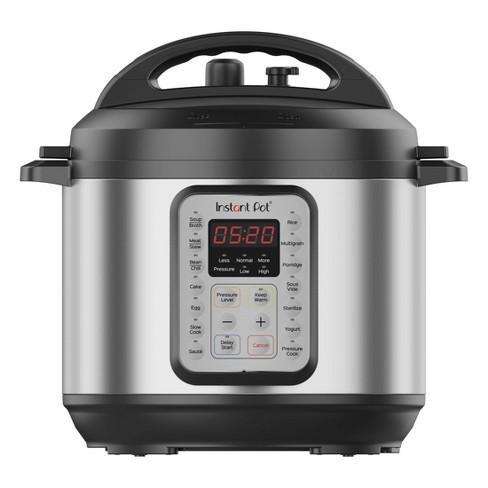How Long Does Instant Pot Come to Pressure?
We often hear how fast a pressure cooker is compared to the other cooking methods. Most users forget that pressure cookers need to come to pressure so that the cooking process can begin.
A pressure cooker takes 5 to 30 minutes to come to pressure. Several factors determine how fast an instant pot reaches its maximum pressure. The major factors include the quantity of the food being prepared, temperature, and the quantity of water.
An instant pot coming to pressure can be compared to an oven pre-heating before the cooking commences.
When your instant pot is ready to start cooking, it’ll start to count down. You may also hear a hissing sound as excess pressure is released.

Why Is My Instant Pot Taking So Long to Come to Pressure?
Here are some reasons why the instant pot may take longer to come to pressure.
1. The Instant Pot is Too Full
When adding food and liquid to the pressure cooker, there needs to be adequate room for the formation and circulation of steam.
Remember, for a pressure cooker to function, there must be steam that increases the temperature and pressure of the liquid.
If the instant pot is too full, the steam will not circulate and the appliance will display an error. You’ll get a burn notice.
Ensure that you don’t fill the instant pot beyond the max line on the pressure cooker. A safer bet is to ensure that the appliance is not more than 2/3 full.
Another factor to consider when filling the pot is the type of food you’re preparing. If the food absorbs water and expands, leave room for this occurrence.
Also, soak these types of food e.g., beans before cooking to reduce the extent of expansion.
2. There Isn’t Enough Liquid
An instant pot needs adequate liquid to build up pressure. The minimum amount you can add to the pot is 1 cup.
You require more water when preparing heavy meals that have a longer cooking time. Examine your recipe and add a provision of about half a cup that will allow the pressure cooker to come to pressure.
There needs to be a balance between too much and too little water. Feel free to add more water as the cooking process takes place to avoid having the pot too full.
Read about How Much Water Is Needed for Pressure Cooking.
3. Cold Instant Pot Contents
It may take longer for the instant pot to come to pressure when the food and liquid in the pressure cooker are too cold.
It’ll take time for the pressure cooker to heat the contents and become hot enough to produce steam.
To reduce this time, avoid putting food straight from the freezer in the instant pot. Give time for the foodstuffs to thaw or place them in a water bath to increase their temperature.
Another great way to speed up the processes in the pressure cooker is to use a warm or hot liquid. This significantly reduces the time an instant pot takes to come to pressure.
4. Faulty Sealing Ring
The sealing ring is a round rubber ring that fits on the instant pot lid. It works to keep the steam inside the pot.
When the sealing ring is not placed correctly, is worn out, or broken it won’t work as needed. You’ll notice that steam escapes from the side of the instant pot.
If this happens the electric pressure cooker will take long or won’t come to pressure. Examine the condition of the sealing ring and replace it if needed.
It’s recommended to have spare sealing rings as they often damage and prevent the use of your kitchen appliance.
5. The Liquid is Too Thick
A thick liquid will take longer to produce steam or fail to vaporize. Check the consistency of the liquid. If thick, add a cup or half cup of water.
Also, avoid adding thickening agents to the instant pot. They interfere with the mechanism of the instant pot and may cause the appliance to take longer to cook.
6. Faulty Release Valve
A faulty release valve can affect the time the instant pot comes to pressure if it’s releasing steam before being prompted.
Check on the condition of the steam release valve. It may be damaged, open or not fixed correctly. Adjust it and ensure it seals so that steam does not escape.
Find out How Long to Wait Before Opening a Pressure Cooker
7. Blockage
Another check is for blockage in the instant pot. Inspect the inner pot, exhaust valve, steam release, and anti-block shield for stuck food particles. Some spots may have been missed when cleaning.
Also, ensure that the food is not stuck on the bottom of the pot. Stir the food and allow for the water to sip through to the bottom.
8. Damaged Lid or Pot
In case all the above have failed. There might be a problem with the lid or pot. You may need to consult Instant Pot or a professional to test the appliance.
In extreme cases, you may need to replace the instant pot.
Why Is Natural Release Taking So Long?
Natural release in an instant pot is when you allow the cooker to cool naturally over time. A natural release can take 5 to 30 minutes.
The process of natural release can take longer if the pot is full of stock or food. There may also be an issue with the steam vent. Also, ensure that the steam handle is positioned to vent and not seal.
Before deciding to use natural release check what your recipe requires. If it recommends quick release, use it to prevent food from overcooking.
Natural Vs Quick Release in a Pressure Cooker
As mentioned above natural release allows the pressure cooker to cool naturally without you needing to take any action. Quick release on the other hand requires you to use the steam release handle. You’ll switch the handle from sealing to venting.
When this handle is shifted, a jet of steam is released from the pressure cooker. Once the release is complete, the float valve drops and the lid opens.
Check out: Best Stovetop Pressure Cooker Reviews
Conclusion
It takes an instant pot 5 to 30 minutes to come to pressure. The exact time it takes depends on the amount of food and liquid in the pot.
Ensure that you add appropriate amounts of food and liquid to the pressure cooker. Too little or too much will affect the working of the appliance.
Also, inspect sections of the instant pot to ascertain that they are in the right position and are working correctly.



